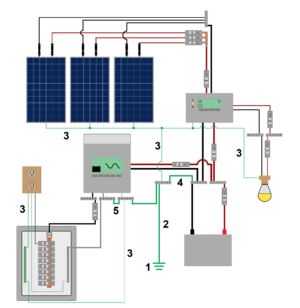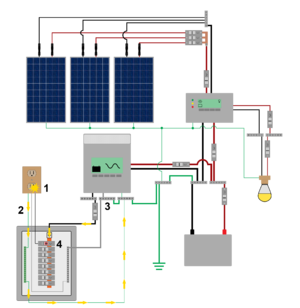Grounding system
A grounding system creates a low-resistance connection between system equipment and/or a system conductor (wire) - called a neutral or grounded conductor - to the earth by using a grounding electrode. A grounding system is not necessary for an electrical system to function, the electrical distribution systems in some countries lack any type of grounding and others have complex grounding systems with additional measurement devices to protect users. It is common for many small-scale off-grid systems to lack a grounding system as it significantly increases costs and installation time and may not yield significant benefits. As system size, voltage, and cost increase the benefits of a grounding system grow. The electrical code for every country will contain information about the requirements and appropriate equipment for that location.[1]
Additionally, it is necessary to consult the manual for any charge controller or inverter before deciding upon a grounding scheme as they may have different requirements for grounding. There are a few cases that are worth noting here:
- There are some small inverters - modified sine wave and square wave - that will be destroyed if they are connected in a system that has both an AC and a DC system ground as they do not properly isolate their DC input from the AC output.
- There are some charge controllers that are intended for specific applications, like remote telecommunications installations, that are positively grounded.
Contents
Grounding terminology
Most off-grid equipment can be used in a variety of different grounding configurations - there is no universal configuration. The focus here will be on a TN-S grounding configuration, which is commonly used for off-grid PV installations. This configuration has a system ground that creates a grounded conductor (neutral). There is a separate equipment ground that is run with each circuit to bond together non-current carrying metal parts of the system (enclosures, junction boxes, major system components etc.).[2] A TN-S grounding configuration has two major functions that work together:
- System grounding - System grounding is created by connecting one current-carrying conductor of an electrical system to ground. A proper system ground provides a means to dissipate excess static electricity created by friction or lightning. This helps to ensure a stable voltage and protect system equipment from damage.
- Equipment grounding - Equipment grounding is created by connecting all non-current carrying metallic components of a system to ground. This creates a path for any current created by a fault - due to failure of insulation or a loose connection - to return through the equipment grounding or the earth to the grounded conductor.
A proper grounding system requires various different components that are connected together in order for the system to work effectively and safely.
| Component | Function |
|---|---|
| (1) Grounding electrode | The connection point between the earth and the electrical system. It is important that a grounding electrode have sufficient surface area in contact with the earth in order to establish a good connection. There are many different types of grounding electrodes - copper rods, steel rods, copper plates, the metallic pipes of a building, or a proper connection to the rebar used in the foundation of a building. The appropriate grounding electrode will vary based upon the electrical code, building and soil type. |
| (2) Grounding electrode conductor (GEC) | The connection that runs from the grounding electrode to the location of the rest of the electrical equipment - typically a wire that runs from the grounding electrode to a grounding busbar in the main distribution panel. |
| (3) Equipment grounding conductor (EGC) | The connection that runs from the grounding busbar in the main service panel to all of the non-current carrying metallic components of a system (conduit, inverter housing, charge controller housing, enclosures, etc.). |
| (4) DC system ground | The connection between a DC current carrying conductor in an electrical system and the grounding electrode conductor - commonly made through a ground fault protection device. |
| (5) AC system ground | The connection between an AC current carrying conductor in an electrical system and the grounding electrode conductor - typically made immediately after the inverter output at a busbar used for the inverter output circuit or in the main distribution panel. The connection is made from the main grounding busbar to the busbar of the grounded conductor. There are some inverters that come with a pre-established internal system ground, for example any that come with an integrated ground fault protection device (GFPD). A second system ground should not be created; if there is more than one the grounding system will not function properly. |
There are several terms that are used when discussing off-grid PV systems and grounding that are important to understand:
| Term | Definition |
|---|---|
| Non-current carrying conductor | A conductor that is not intended to regularly carry current as a part of the normal functioning of an electrical system. All grounding system wiring fit into this category. |
| Current carrying conductor | A conductor that is intended to regularly carry current as part of the normal functioning of an electrical system. All circuits related to the power generation, energy storage, and distribution to loads fit into this category. |
| Grounded system | A system that has an AC or DC system ground. The system may be a DC grounded system, an AC grounded system, or an AC and DC grounded system. There is at least one grounded current carrying conductor in the system. |
| Ungrounded system | A system that does not have any system ground. There is no grounded current carrying conductor in the system. |
| Grounded conductor | A current carrying conductor that has a connection established to ground by an AC or DC system ground. |
| Ungrounded conductor | A current carrying conductor that does not have a connection established to ground by an AC or DC system ground. |
Ground faults
A ground fault occurs when a current carrying conductor of an electrical system has an insulation failure or comes loose from a connection and makes contact with something that has a connection to ground. Ground faults can be very dangerous because they can lead to electrocutions and fires, therefore it is important to identify them as quickly as possible and disable them. When there is a ground fault, current escapes the wires of a circuit and seeks other paths to be able to complete the circuit. A person who grabs something that has been energized by a fault to ground can become a path to complete the circuit and be electrocuted. In a properly grounded system, the most common ground fault scenario is a ground fault between an ungrounded current-carrying conductor (black wire) and a grounded piece of equipment. A ground fault can occur with a grounded conductor but it will not typically be apparent until there is a second ground fault involving the ungrounded conductor (black wire).
System grounding and equipment grounding work with overcurrent protection devices, ground fault protection devices, residual current devices and inverter electronics to identify faults and disable them as quickly as possible by opening (disconnecting) the circuit. This system functions because a fault to an equipment grounding conductor will create a short circuit if there is low enough resistance, which will activate these devices and cause them to open (disconnect) the circuit.
An AC ground fault involving an ungrounded conductor typically occurs as follows:
- A ground fault occurs between a grounded piece of equipment and an ungrounded conductor (wire).
- The equipment grounding conductor has a connection - due to the system ground - to the grounded conductor of the circuit. The current follows it because it is a low resistance path to the grounded conductor, which completes the circuit.
- The current reaches the grounded conductor and this effectively creates a short-circuit which causes the inverter to supply large a amount of current to the newly created low-resistasnce circuit.
- This high current flow will be identified by the inverter electronics, residual current device (RCD) or an overcurrent protection device (OCPD) as a fault, which will cause the one of them to trip and open (disconnect) the circuit. A RCD or inverter electronics will react quicker than an OCPD.
These devices only temporarily remove the hazard, thus after a ground fault occurs it is necessary to carefully troubleshoot the system to locate the fault and fix it.
Grounded and ungrounded systems in practice
The current carrying conductors in a circuit will behave differently depending upon whether they are grounded or not. Grounded and ungrounded systems each carry different advantages and disadvantages.
Ungrounded system
An ungrounded conductor in an ungrounded system will only have a voltage relative to the other ungrounded conductors in the system, but will not have a voltage relative to ground. For a ground fault to pass current and trip a overcurrent protection devices or a residual current device, two seperate ground faults will be required. This means that a person could touch the busbar of either conductor independently and be safe as long as there is no fault.
Ungrounded systems do not readily identify single ground faults, which represents a significant safety hazard as a user or technician may not discover that a fault exists until contact is made with a conductor that would have had no voltage to ground had it not been for the fault. They can also create other additional double-fault scenarios that do not exist in grounded systems that require an overcurrent protection device on all positive and negative wires in a circuit to be properly mitigated.
| Conductor | Voltage relative to other conductors |
|---|---|
| Ungrounded conductor 1 | Will have full circuit voltage relative to the other ungrounded conductor. Will have no voltage relative to ground. |
| Ungrounded conductor 2 | Will have full circuit voltage relative to the other ungrounded conductor. Will have no voltage relative to ground. |
| Grounding conductors | Will have no voltage relative to either ungrounded conductor 1 or ungrounded conductor 2. |
Grounded system
An ungrounded conductor in a grounded system will have a voltage relative to the grounded conductor and the ground. For a #Ground fault to pass current and trip a overcurrent protection devices or a residual current device, only one ground fault is required: between the ungrounded conductor and the ground. This means in this system that a person could touch the busbar of either the grounded conductor or ground and be safe as long as there is no fault, but not the ungrounded conductor.
Grounded systems are better at readily identifying single ground faults and making users or technicians aware that there is an issue. They also avoid the double-fault scenarios that can be an issue for ungrounded systems.
| Conductor | Voltage relative to other conductors |
|---|---|
| Ungrounded conductor | Will have full circuit voltage relative to the grounded conductor, ground, and any grounded equipment. |
| Grounded conductor | Will have the full circuit voltage relative to the ungrounded conductor. Will have no voltage relative to ground or any grounded equipment. |
| Grounding conductors | Will have full circuit voltage relative to the ungrounded conductor. Will have no voltage relative to the grounded conductor. |
Notes/references
- ↑ Cahiers Techniques 173: Earthing Systems Worldwide and Evolutions https://www.mikeholt.com/documents/mojofiles/electricalearthingworldwide.pdf
- ↑ SMA Grounding in Off-grid Systems: Design of TN and TT Off-Grid https://files.sma.de/downloads/SI-OffGrid-Grounding-TI-en-11.pdf

